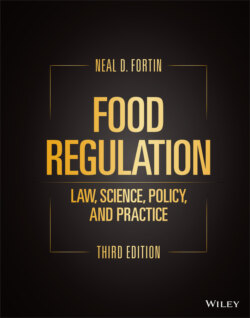Читать книгу Food Regulation - Neal D. Fortin - Страница 139
Soymilk
ОглавлениеIn 2000, the National Milk Producers Federation petitioned the FDA to, “make clear to manufacturers of imitation dairy products that product names permitted by federal standards of identity, including dairy terms such as ‘milk’, are to be used only on foods actually made from milk from animals like cows, goats, and sheep.”63 A number of states adopted so‐called “truth in labeling” laws to prevent plant‐based products from be called “milk.” One slogan about these laws is, “Almonds don’t lactate.”64 These battles can be distilled to three issues: (1) the government’s power to impose standardized names, (2) whether consumer confusion exists over the nature of these products, and (3) whether there are materials facts undisclosed, such as inferior nutritional composition (or what else should the label say).
FDA has defined milk as “the lacteal secretion, practically free from colostrum, obtained by the complete milking of one or more healthy cows… .”65 While the definition is clear that plant‐based products are not “milk,” the issue of qualified names, such as “soymilk,” remains unresolved. Since the 1980 Central Hudson decision, the government needs a substantial interest to restrict commercial speech, and the restriction cannot be more extensive than necessary.66 A complete ban on use of the term “milk” on plant‐based alternatives is likely to be seen as more restrictive than necessary to advance the government’s interest. In short, it is doubtful the FDA has the authority to restrict terms like “soymilk” unless the use is false or misleading.
Consider a similar case with “peanut butter,” which has been around since the late 1880s. No one mistakes peanut paste as a dairy product just because “butter” is in the common name. A number of other items with a butter‐like consistency use “butter” in the name. Likewise, the word “milk” has long been used to refer to food squeezed from nuts and soybeans. The term “soymilk” has been used at least as far back as the 1930s and has been common for the past few decades. In 1997, the Soyfoods Association of North America petitioned the FDA recognize the term “soymilk.”67
After the product has been on the market for decades and has been the subject of millions of dollars of advertising and labeling, make it difficult to claim consumers are misled by the name soymilk. In the absence of a standard of identity for soymilk, the law requires that the product be identified by the common or usual name.68 “Soymilk” may have become the common or usual name in the United States. Even if soymilk is not the common or usual name, the name must accurately identify or describe, in as simple terms as possible, the basic nature of the food or its characterizing properties or ingredients.69 A number of courts have found that “soymilk” is an appropriate statement of identity.70
Nonetheless, debate continues over whether soymilk and similar products fail to disclose material facts about their comparative nutritional composition. However, such comparisons are complicated. Cow’s milk is an excellent source of protein, calcium, vitamin A, and vitamin D. On the other hand, soymilk contains more fiber than cow’s milk and reduces cholesterol instead of increasing it. Moreover, the Nutrition Facts provide consumers comparison information.
